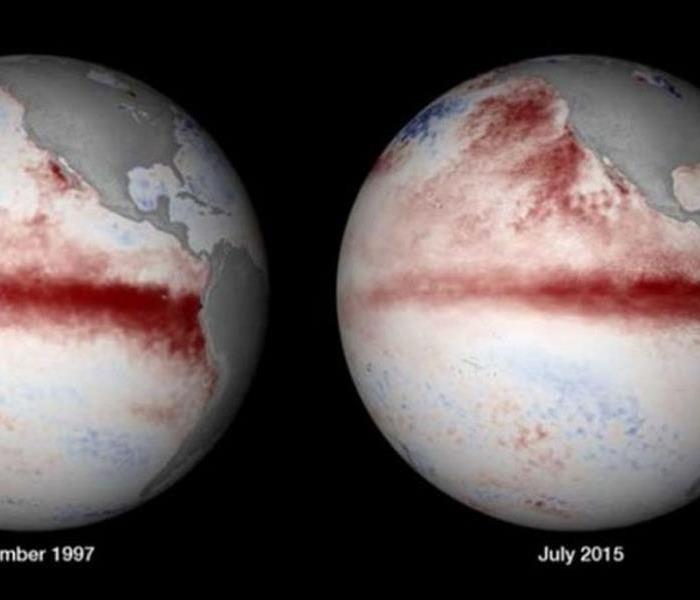El Nino 2015 -- Are you prepared?
10/29/2015 (Permalink)
 Image: This image by the (NOAA) compares the warm Pacific waters of the El Niño 1997-98 event with conditions this summer.
Image: This image by the (NOAA) compares the warm Pacific waters of the El Niño 1997-98 event with conditions this summer.
You may have heard on the news that the El Nino is strong this year, but how strong? The article below is a quick read but provides useful tips on how everyone should prepare for this winter. - Dave K
WHAT YOU SHOULD DO NOW TO PREPARE FOR EL NINO
Statewide, 17 people died.
Big waves and mudslides alike washed away roads and indiscriminately submerged Malibu mansions and hillside apartments buildings.
Rivers overflowed, seven inches of rain fell in a single day, and the damage cost California more than $400 million. It was California’s wettest winter on record. It was the El Niño 1997-98.
While climate models hint that the coming El Niño can rival or surpass the 1997-98 El Niño, most experts admit the weather phenomenon is as truly temperamental as a toddler. The coming rainfall may be unpredictable, but one thing is not: a decade of drought and catastrophic wildfires have left the parched landscape as ill-prepared for torrential rain as it is in need of it.
Experts at FEMA say now is the time to prepare for El Niño.
“Flooding is the most expensive natural disaster in the United States,” said Olivia Humilde, FEMA’s Mitigation Outreach Specialist. “We all know that mother nature will do her thing, and you can’t really control it.”
But you can prepare for it.
The first step, says Humilde, is to know your risk. Residents living in low-lying beachfront homes such as those in Seal Beach are aware of their flood risks, but folks living in drought-stricken or fire-ravaged canyons may not be aware that conditions are uniquely aligned for mudslides.
“If you are in a wildfire area and the area around you has burned, the land can’t absorb that water,” Humilde said.
Residents can identify their flood risk by entering their addresses at the government’s floodsmart website.
Most homeowners’ insurance policies don’t cover flooding. If you think your home is at risk of flooding this winter, now is the time to buy flood insurance, said Humilde. Policies take 30 days to go into effect, she added. Policies that cover building and contents cost less than $500 a year, she said. The floodsmart website includes information about flood insurance and links to insurance agents.
Even more important than insuring your home is preparing your family for an emergency.
Humilde advises families to put together a disaster supply kit and to practice a family communication plan. A basic disaster supply kit, should include a clear gallon tub filled with:
A family communication plan should prepare everyone in the family for the possibility of an emergency during the day when children may be at school or parents at work. Families should designate a first point of contact to check in with and a place to evacuate to. Social media can be a very efficient way to communicate with one another, said Humilde. A communication plan could include an emergency family twitter hashtag.
“An emergency is stressful enough,” said Humilde. “Knowing you have plan in place is really helpful.”
Article by Paige Austin, Los Alamitos-Seal Beach Patch





 24/7 Emergency Service
24/7 Emergency Service